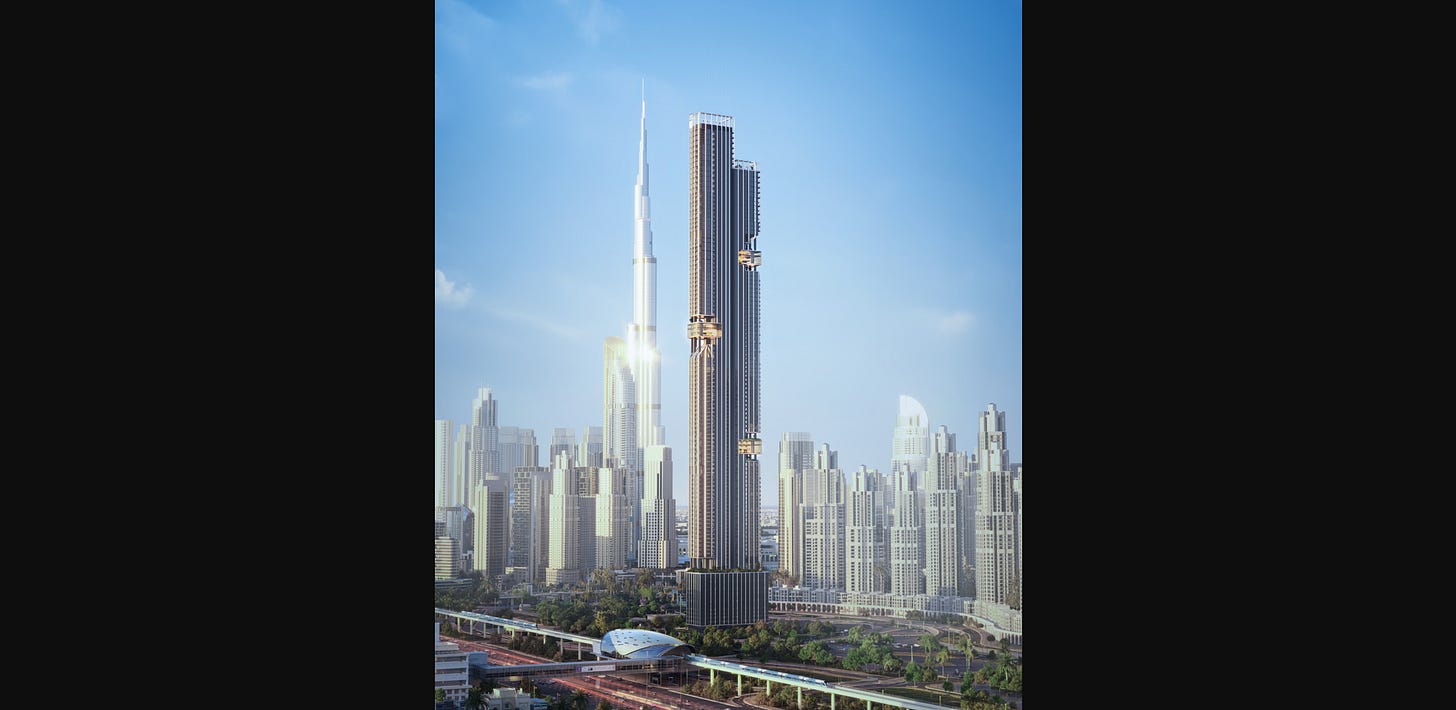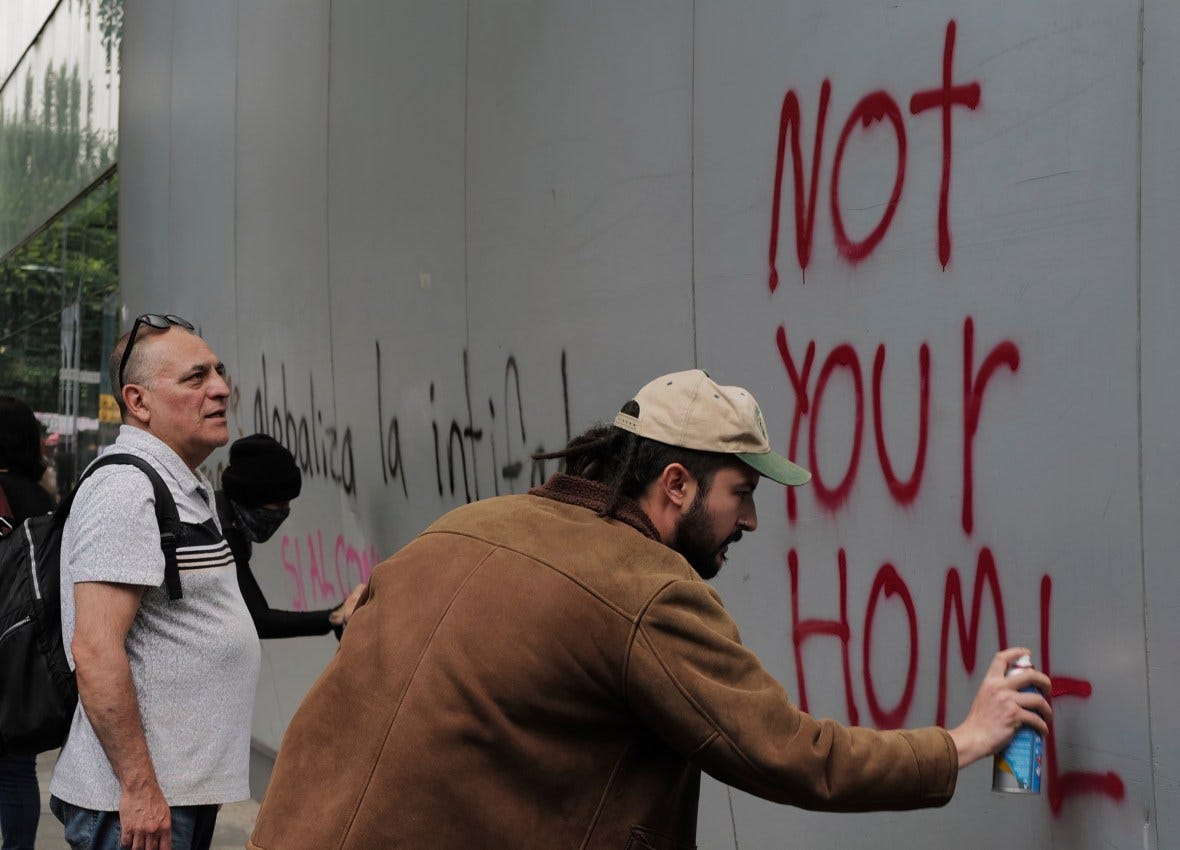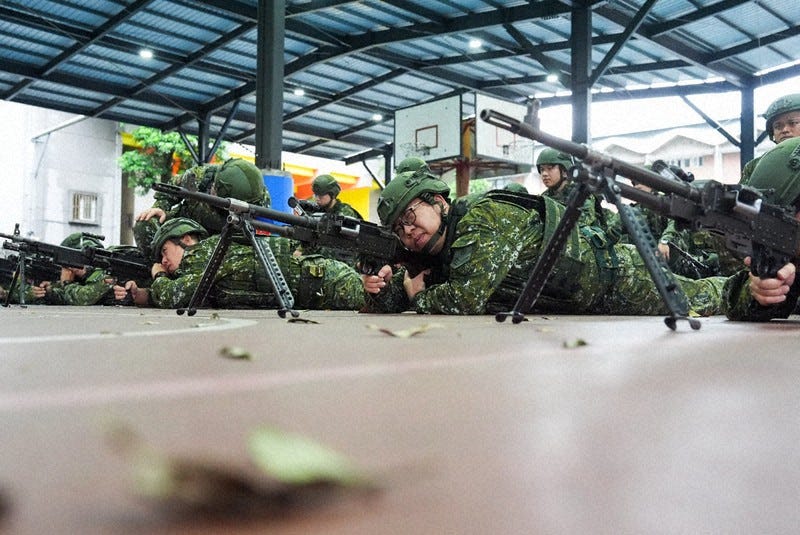Notes from the edge of civilization: July 13, 2025
Meet the zero-minute city; Mexico City says 'Gringo go home!'; Taiwan war games get real.
If you thought 15-minute cities were dystopian, buckle up! A developer in Dubai is taking things to the next level.
Deyaar Development PJSC has decided to skip the oneupmanship of 14-minute cities, or 12-minute cities, or even 10-minute cities. Nope! The company went straight to the zero-minute city, in the form of a massive skyscraper. That’s right: you’ll go nowhere, and pay for the privilege.
Deyaar just unveiled plans for their 110-story luxury containment tower — DWTN Residences at Business Bay. According to their senior VP, Hamdan Al Kaitoob,
“Having a 100-story building, it makes it hard for people to leave and come back, so we created all of that within that same space.”
Translation: Don’t bother with the messy, unpredictable world outside. We’ve designed your life, curated your experiences, and piped in a synthetic version of nature — and you’ll never even need to take your slippers off.
After all, you wouldn’t want tenants escaping the ecosystem. Far better to build them a gilded cage, fill it with lifestyle distractions, and charge them a pretty penny to be gently domesticated.
So what do you get inside this sky-high simulation? Air yoga zones, floating zen gardens, AI-powered meditation pods. And the pièce de résistance: an “invisible spa” — that’s so incredible it’s practically indescribable. Here’s Al Kaitoob making an effort:
“Marketing can can have a lot of words, but it's actually a very high-end spa where it is trying to be at the same level of what luxury we're trying to provide… so the spa obviously… well, the renders are amazing…”
It’s a perfect metaphor, really. This spa is so elite it transcends language. And reality. Kind of like how the ruling class interacts with the rest of us schlubs: glossy, out of touch, and vaguely pretending we don’t even exist.
Basically, this tower is an experimental behavior enclosure, disguised as the utmost in convenience. A self-contained ecosystem engineered to blur the lines between autonomy and algorithm, community and surveillance.
If this is the future of “smart living,” then the 100th-floor infinity pool isn’t just a luxury perk — it’s a symbol. Because from up there, you can’t see the ground at all.
When citizens of a failing empire become the economic refugees of their own collapsing system, you get Mexico City.
It’s where late-stage capitalism had a meet-up with digital nomadism and inflated salaries and where the lines between expat, tourist, and colonizer have blurred. As the streets of Mexico City made clear on July 4th, you can’t gentrify the world without someone noticing — and eventually, resisting.
While Americans back home celebrated their independence with BBQs and flags, a different kind of fireworks erupted in the upscale Condesa neighborhood. Protesters stormed a Starbucks — prime territory for remote-working gringos sipping flat whites and running Zoom calls from paradise (not to mention a classic symbol of the empire). Windows were smashed, chairs thrown. Snacks were looted and tossed into a crowd waving signs that didn’t mince words: “Expat = Gentrifier.” “Gentrification is Colonization.” “Not Your Home.”
It’s a clear, if uncomfortable, message — and it highlights a tension that can’t be neatly resolved. Americans flood into Mexico with no visa panic or border walls, while migrants in the US are being rounded up and deported back home.
Since the pandemic, Mexico City has become a refuge for the post-American burnout class: yoga instructors, crypto bros, and startup refugees looking for affordable cosmopolitanism. Condesa — once a quirky, walkable neighborhood with deep local culture — has morphed into an enclave where English is the default, rent has doubled, and the hottest export is overpriced AirBnB “experiences.”
Locals noticed. The culture didn’t feel like theirs anymore. Taquerías gave way to turmeric lattes. Vinyl-and-vintage concept stores replaced corner markets. The vibe, once rooted in community, now caters to the algorithm.
The Mexican president condemned the violence and tried to walk a fine line — denouncing xenophobia while acknowledging that unchecked gentrification is, in fact, a problem. But on the street, the sentiment is blunt: you came for cheap tacos and authenticity, but brought Whole Foods prices and entitlement.
This might be what collapse looks like — the slow suffocation of a city’s character under a pile of cash, cameras, and curated identities. The expats came chasing paradise, and found a population tired of being someone else’s discount Eden.
Taiwan is in the thick of its largest-ever annual military drill — 10 days of full-spectrum readiness involving 22,000 reservists along with civil defense exercises blanketing the archipelago. Troops are simulating Chinese beach landings and civilians are being trained in air-raid response, evacuation protocols, and how to distribute humanitarian supplies. This seems more like a dress rehearsal than a drill.
The scale and scope of this year's drills reflect the island's growing apprehension, but also its desire to apply lessons learned from recent conflicts in Europe and the Middle East, for example, about asymmetric weapons systems and territorial defense.
Relations between Taiwan and China have also become particularly tense under the leadership of Taiwan’s president, William Lai, who was elected last year. Lai has given four of 10 planned speeches meant to prepare the public for increasing pressure from Beijing. Translation: he's soft-launching the coming war in easy-to-digest installments.
China, for its part, calls Lai a "troublemaker" who is "stirring up confrontation,” but it isn’t exactly dialing down the tension, either. China’s staged live-fire drills with amphibious assault units and released video of soldiers practicing armed swimming, underwater combat, and long-range coastal infiltration drills.
Basically, it’s all fun and war games — until someone actually pulls the trigger.





A gilded cage is still a cage🤔
Several points in the "gentrification" of Mexico.
First of all I totally get it. A country has a cultural identity. Having enclaves of people from outside the culture that don't integrate destroys the unifying force of the culture. You get a bunch of people that come in and demand that everyone conforms to their culture.
Then there is the double standard. If people in Mexico want to keep out the encroachment of foreigners, they are making a noble effort at preserving their culture. If we do it here the US, we are just being racist and xenophobes.
It is the whole idea of gentrification is just a load of nonsense. You don't just build a neighborhood and allow it to rot down to the ground. It takes money and work to fight entropy. You rebuild the neighborhood as it deteriorates and you don't get to go back and pull materials and labor from a time machine that has the prices people paid 50-60 years ago. The higher prices for labor and materials makes the properties more expensive. Add to that the increased cost of remodeling and bringing old structures up to modern standards and yes, it makes the areas more expensive. Especially in light of Mexico City being subject to earthquakes, higher environmental standards, and power demands for modern life.
It is also rich when a population points to colonization as being evil when they themselves are a product of multiple waves of conquest and colonization. They had waves of it from the Olmecs, Teotihuacan, Mayan, Toltecs, and Aztecs and more long before the Spaniards joined in. Then the French. They have a long history of immigrants from other places as well, much like the US.
That said, if I were to move to Mexico, the last place I would want to be is around a bunch of snobby expatriates from where I left. It defeats the whole purpose of moving to a different place. Of course where I live, it would a pointless move. The vast majority of people here (more than around 90%)are either actually from Mexico or just a generation or two removed. It even used to be part of Mexico. Many of the people here have families that straddle the border. People still move between the countries fairly fluidly. Every day, there are people cross the border both ways to shop, work or attend school. Endless truckloads of produce pass through here bound for stores all over the country. Manufacturing shuttles goods back and forth between production facilities here in the US and in Mexico.